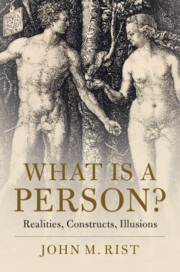Book contents
- What is a Person?
- What is a Person?
- Copyright page
- Contents
- Acknowledgments
- Introduction
- Part I Constructing the ‘Mainline Tradition’
- Part II No God, no Soul: What Person?
- Part III Toward Disabling the Person
- Part IV Persons Restored or Final Solution?
- 21 Parfit and Heidegger
- 22 Strawson and Nagel
- 23 Personalism, Phenomenology, Edith Stein
- 24 God Made Adam and Eve
- Epilogue or Epitaph?
- Appendix The World of Rights Transformed Again
- Bibliography
- Index
22 - Strawson and Nagel
from Part IV - Persons Restored or Final Solution?
Published online by Cambridge University Press: 05 December 2019
- What is a Person?
- What is a Person?
- Copyright page
- Contents
- Acknowledgments
- Introduction
- Part I Constructing the ‘Mainline Tradition’
- Part II No God, no Soul: What Person?
- Part III Toward Disabling the Person
- Part IV Persons Restored or Final Solution?
- 21 Parfit and Heidegger
- 22 Strawson and Nagel
- 23 Personalism, Phenomenology, Edith Stein
- 24 God Made Adam and Eve
- Epilogue or Epitaph?
- Appendix The World of Rights Transformed Again
- Bibliography
- Index
Summary
After our brief glance at Parfit and Heidegger, who in their different ways represent the highwater mark of the destruction of the Mainline Tradition, I turn to two recent writers who, again in different ways, have adopted a more positive, but ultimately inadequate approach to persons. The first is P. F. Strawson, who in 1959 published a much-lauded book on individuals with the subtitle An Essay in Descriptive Metaphysics.1 As this subtitle indicates, it is intended as a description of human beings (persons) as a subset of individuals without immediate attention to their possible dignity, though that is assumed, predictably, insofar as they are possessed of consciousness, as other animals are not. Since Strawson’s book largely eschews even the possibility of the existence of God, one must assume that whatever value his persons have will derive, as in Kant, from their ability to operate in accordance with right reason. As with Strawson’s Oxford successor Parfit, we have also to assume that norms, including moral norms, derive from rational capacity: thus evil acts are evil insofar as they are irrational, though Strawson offers no more defence of that claim than do most other contemporary philosophers. Were it correct, we should have to assume that the only thing wrong with, say, the Holocaust was that it was irrational.
- Type
- Chapter
- Information
- What is a Person?Realities, Constructs, Illusions, pp. 212 - 215Publisher: Cambridge University PressPrint publication year: 2019

